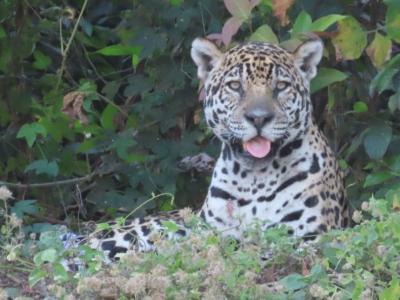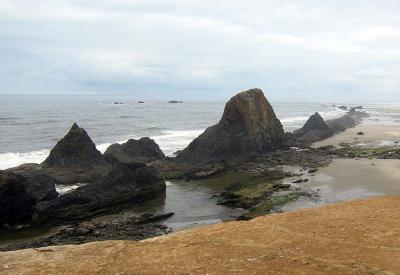Mexico: The Yucatan and Cozumel
-
Jan 11-19, 2026
Rich Hoyer and Roland Rumm
Tour Price to be Determined
Tour Price to be Determined
Mexico’s Yucatan Peninsula is famous for its spectacular Maya ruins, warm climate, and delicious regional cuisine. It is also a notable center of bird endemism with species such as Black-throated (Yucatan) Bobwhite, Yellow-lored (Yucatan) Parrot, Yucatan Woodpecker, Yucatan Wren, and the recently split Yucatan Gnatcatcher. This tour distills the best of the Yucatan into a short, unhurried trip that takes in the peninsula’s dry forest, coastal scrub, lagoons, mangroves, and tall humid forest before ending on Isla Cozumel, with its Caribbean flavor, island endemics, and great snorkeling. At this season many migrant warblers from eastern North America are present, and flocks of resident flamingos feed among throngs of migrant shorebirds.
Day 1: The trip begins at 6:30 pm at our hotel south of Cancún. Night in Puerto Morelos.
Day 2: Today we’ll drive south, birding at an attractive botanical garden in the morning, and then continuing south to the town of Felipe Carrillo Puerto, our base for two nights in the Zona Maya. After lunch and a short siesta we’ll head out to bird in the forest and forest edge near town, staying out after dark in hope of encountering a Yucatan Poorwill or some other nocturnal critters. Night in Felipe Carrillo Puerto.
Day 3: We’ll have a full day’s birding in the rich forests near town, where species include Ornate Hawk-Eagle, Wedge-tailed Sabrewing, Keel-billed Toucan, Northern Bentbill, White-browed Gnatcatcher, Blue Bunting, and the very local Gray-throated Chat and Rose-throated Tanager. We even have a fair chance of coming across a swarm of army ants, which should be attended by Ruddy and Northern Barred Woodcreepers. Night in Felipe Carrillo Puerto.
Day 4: We’ll spend the morning birdwatching in the forest near our hotel, where we’re sure to add some new species. After lunch we’ll drive north to the picturesque Yucatan town of Valladolid. Night in Valladolid.
Day 5: This morning we’ll drive to the nearby ruins of Chichén Itzá, where the surrounding woodland will provide another taste of the Yucatan’s distinctive avifauna. Birds here include Ferruginous Pygmy-Owl, Cinnamon Hummingbird, Turquoise-browed Motmot, Yucatan Jay, and Orange Oriole. There will be time to view the ruins, the remains of one of the most complex of all Late Classic Maya ceremonial centers. After lunch we’ll head north toward Dzilam de Bravo, which hosts a healthy population of the recently split Yucatan Gnatcatcher. Once we are successful, we’ll head east to Rio Lagartos, our base for the next two nights. Night in Rio Lagartos.
Day 6: Today we’ll bird locally around Rio Lagartos. The arid scrub here is home to two very local endemics, the tiny Mexican Sheartail and the garrulous Yucatan Wren, both of which we should see. We’ll take a boat trip through mangrove-fringed lagoons in search of American Flamingo, Reddish Egret and Boat-billed Heron. After lunch we’ll visit nearby coastal areas adjacent to a huge salt works, home to Snowy Plover, Zenaida Dove, and flocks of migrant shorebirds that support wintering Peregrine Falcon and Merlin. Night in Rio Lagartos.
Day 7: With another morning around Rio Lagartos, we’ll bird locally targeting anything that we may have perhaps missed previously. We’ll then drive to Playa del Carmen for a ferry ride to the Caribbean island of Cozumel. Night in Cozumel.
Day 8: Mexico’s Cozumel Island has an interesting mix of Caribbean, Yucatan Peninsula, and island-endemic birds. We’ll spend a leisurely day exploring the island in search of White-crowned Pigeon, Cozumel Emerald, Caribbean Elaenia, Black Catbird, Yucatan and Cozumel Vireos, the very distinctive and endemic form of House Wren, Western Spindalis, and the distinctive races (or species?) of Bananaquit and Blue-gray Gnatcatcher. Wintering migrants include Palm, Prairie, Cape May, Yellow-throated, and Swainson’s Warblers. Night in Cozumel.
Day 9: The tour concludes this morning in Cozumel. We’ll have an optional early morning walk to look for anything we may have missed before returning to the hotel and our transfer to the airport for flights homeward.
Note: The information presented here is an abbreviated version of our formal General Information for this tour. Its purpose is solely to give readers a sense of what might be involved if they take this tour. Although we do our best to make sure that what follows here is completely accurate, it should not be used as a replacement for the formal document which will be sent to all tour registrants, and whose contents supersedes any information contained here.
ENTERING MEXICO: U.S. citizens traveling to and from Mexico must have a valid passport valid for at least six months after the tour’s ending date, and with at least one blank page for an entry stamps. Citizens of other countries may need a visa and should check their nearest Mexican embassy. If required by the embassy or visa-granting entity, WINGS can provide a letter for you to use regarding your participation in the tour.
COUNTRY INFORMATION: You can review the U.S. Department of State Country Specific Travel Information here: https://travel.state.gov/content/travel.html and the CIA World Factbook here: https://www.cia.gov/the-world-factbook/. Review foreign travel advice from the UK government here: https://www.gov.uk/foreign-travel-advice and travel advice and advisories from the Government of Canada here: https://travel.gc.ca/travelling/advisories.
PACE OF THE TOUR: We start most mornings with picnic breakfast at 6:30 (EST when in Quintana Roo) or 5:30 (CST when in Yucatán), with departure for birding a half-hour later. It gets dark early (by 7 p.m. EST) so we won’t be out late except one night of owling, when we may have a later dinner soon after returning to town. On half of the days there will be the opportunity for a siesta break after lunch, followed by afternoon birding, and nearly every day we schedule an hour off before dinner.
Almost all the birding is along level roads or largely flat ground, with no narrow forest trails. We walk slowly and since birding often involves standing still for periods, some people like to have a small travel stool to sit on. One day we’ll take a boat trip for about three hours in mangrove lagoons. The only climbing you will need to do is in our hotels, most of which do not have elevators but do have two or three stories.
HEALTH: The Centers for Disease Control and Prevention (CDC) recommends that all travelers be up to date on routine vaccinations. These include measles-mumps-rubella (MMR) vaccine, diphtheria-tetanus-pertussis vaccine, varicella (chickenpox) vaccine, polio vaccine, and your yearly flu shot. They further recommend that most travelers have protection against Hepatitis A and Typhoid.
Please contact your doctor well in advance of your tour’s departure as some medications must be initiated weeks before the period of possible exposure.
No specific inoculations are necessary. Special medications may be unavailable so bring enough to cover your needs for the entire trip.
The most current information about travelers’ health recommendations can be found on the CDC’s Travel Health website here: https://wwwnc.cdc.gov/travel/destinations/list
Insects: Biting insects and arachnids are seldom a major nuisance although chiggers can be locally numerous, and mosquito numbers vary greatly from year to year. Cozumel typically has the most mosquitos, especially in the evening near the mangroves. Bring a good insect repellent for mosquitoes and other insects that we’ll occasionally encounter.
Smoking: Smoking or vaping is prohibited in the vehicles or when the group is gathered for meals, checklists, etc. If you are sharing a room with a nonsmoker, please do not smoke in the room. If you smoke in the field, do so well away and downwind from the group. If any location where the group is gathered has a stricter policy than the WINGS policy, that stricter policy will prevail.
Miscellaneous: We do not often encounter snakes and take time to observe them whenever possible; most are not venomous, and venomous ones are not aggressive.
We avoid tap water but filtered and bottled water are readily available at our hotels in the tour vehicles, and any water and ice served at restaurant tables is drinkable. Gastrointestinal problems are always a possibility while traveling; you may want to bring Imodium or some other reliable anti-diarrhea medication. Finally, you may wish to bring a broad-spectrum antibiotic in case of stubborn bacterial infections.
The sun in Mexico can be very intense. Please bring adequate protection, including a sun hat and a strong sun screen of at least 30 SPF rating.
CLIMATE: We’ll be here during the winter dry season, but weather is always unpredictable, and a cold front could pass through at any time. Daytime highs could reach the low 90s with lows possibly in the 50’s (°F) range. It is usually humid and rain is quite possible.
ACCOMMODATIONS: Our hotels and lodges are always among the best available among the smaller hotels (we try to avoid the larger, all-inclusive resorts). The Hotel Hacienda Morelos is a comfortable hotel right on the beach, with fans and a/c in all rooms, and a refreshing swimming pool. The Hotel Esquivel in Felipe Carrillo Puerto is a basic Mexican hotel away from the touristy areas, so nothing fancy should be expected. It has a/c and ceiling fans in the rooms, is only a few miles from our excellent birding road, and has a restaurant that serves a good variety of Mexican food and local specialties. The El Mesón del Marqués in Valladolid is a pleasant historic hotel with an excellent restaurant, set on the corner of the colonial zócalo (town square) opposite a large cathedral. The hotel in Rio Lagartos is nothing fancy but room, with refrigerator and air conditioning. The hotel on Cozumel is a modern resort hotel with all of the usual facilities and is located right across the street from a good snorkeling opportunity, especially for beginners.
FOOD: We have picnic breakfasts most days, consisting of various bakery products, cheese, yogurt, and bananas. Lunches and dinners are in restaurants and are typically very good; most dishes are not spicy unless hot sauce is added; and this can be very hot indeed in the Yucatan, the home of the habanero pepper.
Food Allergies / Requirements: We cannot guarantee that all food allergies can be accommodated at every destination. Participants with significant food allergies or special dietary requirements should bring appropriate foods with them for those times when their needs cannot be met. Announced meal times are always approximate depending on how the day unfolds. Participants who need to eat according to a fixed schedule should bring supplemental food. Please contact the WINGS office if you have any questions.
TRANSPORTATION: We will be traveling by 12-passenger van or minivan, depending on the group size. When using 12-passenger vans, we take a maximum of seven passengers plus the leader. Participants must be able to ride in any seat in our tour vehicle; anyone susceptible to motion sickness should bring an appropriate remedy.
2023 Narrative
In Brief: The American Flamingo might be the Yucatan Peninsula’s most iconic bird, and we learned that the lawn ornament is no substitute for seeing the real thing. From distant splashes of shocking pink in the Rio Lagartos estuary, to ridiculously stretched-out birds flying over the mangroves, to an astonishing drive-up view of several birds almost too close to focus on, we experienced the essence of this beauty, voted favorite bird of the tour. Also memorable were all birds with Yucatan in the name – regional endemics such as the wren, the gnatcatcher, and the jay, all of which we saw well. Some of the sought-after regional endemics have more descriptive names – Orange Oriole and Yellow-lored Parrot were two that we enjoyed thoroughly. We also experienced a touch of the wider Neotropical region, with favorites being sightings of Northern Potoo, Ferruginous Pygmy-Owl, Middle American Screech-Owl (heard at close range), Collared Aracari, Turquoise-browed Motmot, White-fronted Parrot, Lineated Woodpecker, and Barred Antshrike. One close ant swarm in a perfect viewing situation had us captivated for 40 minutes with about 10 species of birds taking advantage of the easy pickings. It was also fun to become familiar with birds on their non-breeding grounds, having escaped the northern winter, such as a male Painted Bunting and many Magnolia and Black-throated Green Warblers, White-eyed Vireos, not just a few Least Flycatchers, and several waders such as American Avocets. Then of course, there were more than just birds, such as blindingly blue Common Morphos, Crimson-patched Longwings, a giant Morelet’s Crocodile, and mind-numbing numbers of Central American Locusts in one of those swarms we had all only ever read about. The food was great throughout, most dinners enhanced by short walks to seek out local ice cream shops, and capped by our farewell meal at a fine restaurant in Cozumel.
In Detail: Our first morning’s birding stop could have been a little less hectic if the birds had just paced themselves, but instead we had an insane amount of activity all at once. It was pure fun. A Turquoise-browed Motmot was a shock perched on the powerline, as a flock of Yucatan Jays, Plain Chachalacas, and orioles competed for attention. A Lineated Woodpecker flew in out of nowhere and landed on a concrete power pole at close range. A pair of Spot-breasted Wrens at the first stop belted out their gorgeous duet, and we eventually had great views of these special birds. A short stop at El Muyil ruins was lovely, with our first taste of an army ant swarm attended by a Tawny-winged Woodcreeper and Red-throated Ant-Tanagers. A Lesson’s Motmot here was our only one of the tour. In the late afternoon we checked out the recently widened Vigía Chico road, where a Yellow-lored Parrot perched in just the right spot visible through a hole in the canopy. We stayed until dark, seeing a Yucatan Poorwill in flight then perched, followed by the low, purring trill of a Middle American Screech-Owl that refused to come out of hiding. On the way back to town, the eyeshine of a Northern Potoo stood out, and we were able to get decent views through the spotting scope.
With the construction disruption on the Vigía Chico Rd, we tried birding a different road south of town – and the birding was terrific. Gray-throated Chats were common, though it took a while before we had satisfying looks at a stunning male. Spot-breasted Wrens showed even better than the day before, and a group of Collared Aracaris was a great sighting. The top experience of the morning was down a forest trail by a large cenote, where a group of birds revealed a swarm of the tiny Labidus praedator army ants. There couldn’t have been a better place to view the parade of birds that took advantage of the flushed booty – the ants were back in the bushes, and the undergrowth was open. It was particularly fun to watch three species of woodcreepers and learn to tell them apart. Before departing for the afternoon birding, we noticed a bit of bird activity in town, right by the hotel. In our attempt to see the Yellow-winged Tanagers, we instead brought up a Ferruginous Pygmy-Owl and had great views of the lovely Blue-gray Tanager and our only Cinnamon-bellied Saltator. Back out in the field, we were better positioned to view the Mayan Antthrushes in the understory, and strolling along the road we bumped into an easy-to-see foraging male Red-capped Manakin.
We had one last morning near Felipe Carrillo Puerto when we tried the Vigía Chico road again, and despite the continuing roadwork we added some nice birds. A pair of White-fronted Parrots sitting in the early morning sun was an amazing sight; farther down the road a group of Collared Aracaris in a tree over the road was almost comical; a Roadside Hawk called from the top of a tree; Ivory-billed Woodcreeper became the final species of its family added to our list; and at last a Yucatan Flycatcher responded to playback silently, maintaining its perfect streak of being seen on 15 tours. An afternoon devoted to the drive to Valladolid was punctuated by a huge group of wintering Northern Rough-winged Swallows, followed by a White-necked Puffbird on a powerline (only the second time on this tour), and a large group of confiding Yucatan Jays attending yet another army ant swarm, this time of the larger Eciton burchellii, right on the shoulder of the highway. We ended the day on the hotel terrace, deafened by hundreds of Great-tailed Grackles and Bronzed Cowbirds coming to roost in the plaza below while we watched bats departing for the night and a lone Peregrine Falcon claiming for itself the entire city below.
Blue Bunting and Greenish Elaenia were nice additions on our early morning outside of Valladolid, but it was a Lineated Woodpecker that really stole the show there before we continued on to the cultural marvel that is Chichén Itzá. The central plaza, the Caracol observatory, and the cenote were highlights, and we even saw some birds, including our only Masked Tityras and a confiding Turquoise-browed Motmot in the understory. On the drive north, we had to pause in one of the small towns to marvel at a massive locust swarm probably numbering a few million insects. (A query to Liz Bernays resulted in a response from Gregory Sword who studies these, and the species is Schistocerca piceifrons, native to Central America and apparently expanding northward with swarms being seen “only about 100-200 miles south of the US border in the Mexican states of Tamaulipas and Nuevo Leon.”) We then quickly picked up the adorable Yucatan Gnatcatchers in their appropriate habitat while also bringing in a close pair of Barred Antshrikes. Driving onward, we were lucky to catch a glimpse of our only Lesser Roadrunner on the side of the road, while short stops at open fields were full of fun birds such as Indigo Bunting, Vermilion Flycatcher, and Orange Oriole. The late afternoon into the evening was then drawn out by our tire blow-out and the slow process of getting it fixed, but we still managed to get fed and a full night’s sleep, ready for another day of birds.
We had a bit of early morning roadside birding near town, but not before oohing and ahhing at the American Flamingos standing in the shallow estuary straight out from our hotel. On the roadside we quickly found a pair of charming Yucatan Wrens, and later, on the same perch sat a female Mexican Sheartail, both rather local endemics. We coaxed out a White-bellied Wren, having only heard it farther south before being called back by breakfast and the promise of a replacement van. The boat ride on the estuary and mangroves was a fun departure from our usual land birding, with highlights being several Common Black-Hawks, the full complement of herons and terns, and a super compact roost of Sanderlings. In the late afternoon we scanned the salt ponds, getting better views of several shorebirds such as American Avocet, adding Herring and Lesser Black-backed Gulls, and seeing one close Roseate Spoonbill.
One final morning out of Rio Lagartos started with our quickly checking some mangroves behind some houses in town, only to discover our first Blue-winged Teal and a group of American Flamingos right in our faces. Two Black Skimmers demonstrated their marvelous foraging technique in the shallow waters, while a Russet-naped Wood-Rail fed with a group of Red-winged Blackbirds. A side road by a conservation easement gave us a better experience with Yucatan Wrens, yet another Turquoise-browed Motmot, some flushed Black-throated Bobwhite, and our most prolonged views of Orange Oriole. A Bright-rumped Attila in the open acacia-mesquite scrub seemed very out of place. Farther down the road a flurry of activity near our stake-out Botteri’s Sparrow spot resulted in a pair of Morelet’s Seedeaters, a stunning Vermilion Flycatcher, and a male Painted Bunting, whose searing red undersides made it easy to pass off as another Vermilion Flycatcher until one looked in the scope and saw the multicolor details up close. On the drive to Playa del Carmen we paused for a vagrant Sandhill Crane apparently back for its third winter, but a Keel-billed Toucan flying over the high-speed toll road was appreciated only by those in the front seats of the vehicle. We arrived in time to get the 5:00 ferry with about one minute to spare, but the rush was worth not having to wait an hour for the next ferry. Laughing Gulls, Magnificent Frigatebirds, and Brown Pelicans saw us off as we motored towards Cozumel Island.
Cozumel birding was delightfully easy. We had both of the currently accepted endemic species, Cozumel Emerald and Cozumel Vireo, within the first 15 minutes of birding with little effort. Fortunately, there were plenty of other birds on the island, as well as some potential splits, to keep us busy for the rest of the day. A briefly seen Orange-crowned Warbler was a vagrant to the island (and may have been of one of the western subspecies to boot), a pair of Yellow-bellied Elaenias exposed their exaggerated crests, a Mangrove Cuckoo appeared out of nowhere and gave great views, and a Western Spindalis was briefly visible for some. We spent time with the endemic subspecies of House Wren before circumnavigating the island and viewing some ponds with Least Grebe, a Little Blue Heron, and a few other species. In the afternoon, we looked at birds that were only a few yards from us – Northern Jacanas showing their ridiculously long toes, Common Gallinules with their candy-corn bills, several Soras feeding out in the open, and initially very reluctant Ruddy Crakes which then without warning decided to waltz out in the open, a family of four joining even more calling hidden from within the marsh.
With all flights in the afternoon, we had a short bonus morning of birding not far from our hotel on departure day. We were even closer to a skulking Swainson’s Warbler, but it remained out of sight. White-crowned Pigeons were new for the list, and we finally saw Western Spindalis fairly well. Green-breasted Mangos put on a show for us, as did one last Cozumel Emerald.
- Rich Hoyer
Rich Hoyer is a birder extraordinaire. His birding eye and ear skills are phenomenal, and he has an encyclopedic knowledge of avian natural history which he shared with us generously. He was very skilled at helping each of us see each bird. His Spanish language skills were also invaluable.
- Genevieve C. on Mexico: The Yucatan and Cozumel
Maximum group size seven participants with one leader, 10 with two leaders.



































